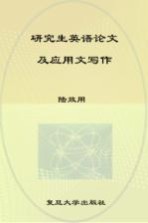图书介绍
研究生英语论文及应用文写作PDF|Epub|txt|kindle电子书版本网盘下载

- 陆效用主编 著
- 出版社: 上海:复旦大学出版社
- ISBN:
- 出版时间:未知
- 标注页数:395页
- 文件大小:9MB
- 文件页数:408页
- 主题词:
PDF下载
下载说明
研究生英语论文及应用文写作PDF格式电子书版下载
下载的文件为RAR压缩包。需要使用解压软件进行解压得到PDF格式图书。建议使用BT下载工具Free Download Manager进行下载,简称FDM(免费,没有广告,支持多平台)。本站资源全部打包为BT种子。所以需要使用专业的BT下载软件进行下载。如BitComet qBittorrent uTorrent等BT下载工具。迅雷目前由于本站不是热门资源。不推荐使用!后期资源热门了。安装了迅雷也可以迅雷进行下载!
(文件页数 要大于 标注页数,上中下等多册电子书除外)
注意:本站所有压缩包均有解压码: 点击下载压缩包解压工具
图书目录
PART ONE 论文写作篇3
Unit One 优秀论文写作概述3
1.1 Introduction3
1.2 Characteristics of Effective Writing4
1.3 Steps to Successful Writing8
1.4 The Style of Academic Writing14
Unit Two 写作技巧:由一般到具体的语篇27
2.1 Introduction27
2.2 The Structure of General-Specific Texts27
2.3 Basic Principles in Writing Definitions29
2.4 Sentence Definitions30
2.5 Extended Definitions37
2.6 Contrastive Definitions40
2.7 Comparative Definitions43
2.8 Generalizations44
Unit Three 写作技巧:先问题后解答的行文44
3.1 Introduction49
3.2 The Structure of Problem-Solution Texts50
3.3 Presenting the Problem51
3.4 Proposing Solutions57
3.5 Evaluation63
Unit Four 写作技巧:图表使用和数据评述71
Ⅰ.Graphic Aids71
4.1 Introduction71
4.2 Types of Graphic Aids72
4.3 Language Focus:Expressions in Describing Graphs82
Ⅱ.Data Commentary83
4.4 Introduction83
4.5 Strength of Claim83
4.6 The Structure of Data Commentary86
4.7 Qualifications and Strength of Claim91
4.8 Concluding a Commentary97
4.9 Dealing with Imperfect Data98
Unit Five 写作技巧:概要写作103
5.1 Introduction103
5.2 Summary,Analysis and Abstract104
5.3 Elements of a Good Summary105
5.4 Characteristics of a Good Summary106
5.5 Steps in Writing a Summary108
5.6 Language Focus:Summary Opening Sentences and Reminder Phrases112
5.7 Comparative Summaries115
Unit Six 写作技巧:评论文写作121
6.1 Introduction121
6.2 Critical Thinking122
6.3 Preliminary Steps in Writing a Critique124
6.4 The Format of the Critique126
6.5 Language Focus:The Grammar of Critiques133
Unit Seven 论文写作:导论及文献综述141
Ⅰ.Introduction Sections141
7.1 Introduction141
7.2 Characteristics of an Effective Introduction142
7.3 How to Write an Introduction147
7.4 Language Focus:Opening Statements151
Ⅱ.Literature Reviews152
7.5 Introduction152
7.6 The Importance of Literature Reviews153
7.7 How to Write a Literature Review154
7.8 Language Focus:Tense in Citation and Negative Statements162
Unit Eight 论文写作:方法与结果169
Ⅰ.Methods169
8.1 Introduction169
8.2 Ingredients of the Methods Section170
8.3 Language Focus:Imperative Sentences178
Ⅱ.Results180
8.4 Introduction180
8.5 Ingredients of the Results Section180
8.6 Commentary in the Results Section183
Unit Nine 论文写作:讨论与结论188
Ⅰ.Discussion188
9.1 Introduction188
9.2 The Variation of Discussion188
9.3 The Difference Between Results and Discussion189
9.4 How to Present the Discussion189
9.5 Strategies for Opening the Discussion Section190
9.6 The Discussion of Results192
Ⅱ.Conclusions194
9.7 Introduction194
9.8 How to Write a Conclusions Section194
9.9 Components of the Conclusions196
9.10 Ineffective Conclusions201
9.11 Language Focus:Transitions and Useful Expressions205
Unit Ten 论文写作:标题、摘要、致谢和文献目录211
Ⅰ.Titles211
10.1 Functions211
10.2 Guidelines212
10.3 Mechanics213
Ⅱ.Abstracts214
10.4 Introduction214
10.5 Components214
10.6 Language Focus:The Grammar of Abstracts216
Ⅲ.Acknowledgements218
10.7 Introduction218
10.8 Components219
10.9 Sample Acknowledgements220
Ⅳ.Bibliographies222
10.10 Introduction222
10.11 Documentation Styles222
10.12 Preferences for Documentation Style229
Unit Eleven 论文写作:抄袭现象和文献引注233
Ⅰ.Plagiarism233
11.1 Introduction233
11.2 How to Avoid Plagiarism234
Ⅱ.Documentation237
11.3 Introduction237
11.4 What to Document238
11.5 In-Text Documentation239
Unit Twelve 学术翻译:论文摘要汉译英253
12.1 Introduction253
12.2 What to Be Translated254
12.3 Language Focus:Linguistic Features of Abstracts256
PART TWO 应用文写作篇273
Unit Thirteen 电子邮件273
13.1 Introduction273
13.2 The Compose Window274
13.3 How to Write and Reply to an E-mail275
13.4 "Body Language"and Acronyms in E-mail276
13.5 Formal E-mail Etiquette278
Unit Fourteen 备忘录285
14.1 Introduction285
14.2 The Format of the Memo285
14.3 Types of Memos287
Unit Fifteen 计划书297
15.1 Introduction297
15.2 The Purpose of a Proposal298
15.3 Components of a Proposal298
15.4 Types of Proposals302
Unit Sixteen 工作进展报告311
16.1 Introduction311
16.2 Contents of a Progress Report312
16.3 The Format of the Progress Report315
Unit Seventeen 简历与信件321
Ⅰ.Résumés321
17.1 Introduction321
17.2 Components of a Résumé322
17.3 The Chronological Résumé328
17.4 The Functional Résumé333
Ⅱ.Application Letters for Graduate Studies336
17.5 Introduction336
17.6 Application Letters for Graduate Programs337
Ⅲ.Job-Application Letters343
17.7 Introduction343
17.8 How to Write Job-Application Letters344
Ⅳ.Recommendation Letters348
17.9 Introduction348
17.10 The Basic Structure of the Recommendation Letter349
17.11 Language Focus:Useful Expressions352
Unit Eighteen 口头陈述357
18.1 Introduction357
18.2 The Role of Oral Presentations358
18.3 Preparing an Oral Presentation359
18.4 Giving the Oral Presentation368
18.5 After the Presentation371